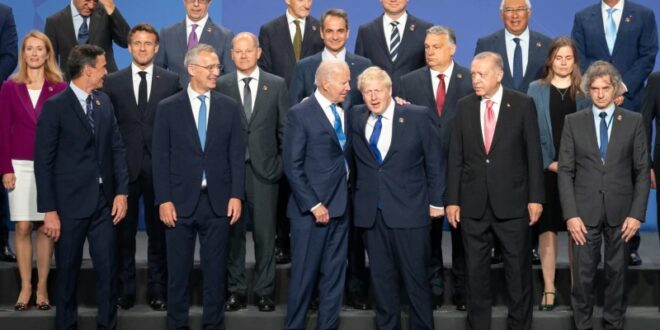The bloc’s formal designation of Beijing as a threat is just a first step. Now comes the hard part.
For the first time since the Mongol invasion of Europe in the 13th century, Europe now views an Asian power as a direct security threat. Unlike Japan, which overran Europe’s East Asian colonies during World War II, China is a superpower with global reach. In NATO’s new Strategic Concept, adopted at its Madrid summit last month, the alliance identifies China’s ambitions and coercive policies as a challenge to its members’ interests, values, and security. However, focusing on China will be fundamentally different from the bloc’s traditional role of warding off territorial threats in Europe, with several fault lines between the United States and NATO’s European members already built in.
Five factors explain NATO’s landmark decision. Some have been familiar parts of the security debate for years; others gained salience only recently.
First—and most obviously—NATO’s strategy is responding to China’s rise and the emergence of a new bipolar international system, replacing the so-called U.S. unipolar moment of the 1990s and early 2000s. With China’s economy estimated to be 25 percent larger than the United States’ by 2026 (measured in GDP at purchasing power parity), Beijing has the resources to further increase a defense budget that is already four times larger than Russia’s. As realists such as political scientist Kenneth Waltz have emphasized, a bipolar power structure compels other states to choose a side. Although the United States announced its rebalance to Asia in 2011, geographic distance and a certain strategic sloth have slowed Europe’s response to China’s growing power. Thus, it has taken Europe and NATO another decade to categorize China’s rise as a security challenge.
Second, technological developments have finally forced Europe’s hand. Here, too, many European countries enjoying growing trade with China and preferring to view Beijing as a partner on all kinds of issues were slow to rise to the challenge. The opportunities for Beijing to weaponize cybertechnology, 5G, and other fourth industrial revolution technologies have brought China closer to Europe. More than any other topic, restricting Huawei’s operations in Europe has dominated the debate on China between Washington and European capitals over the last three or four years.
What accelerated Europe’s shift on China is a third factor: increased uncertainty in Europe about U.S. long-term commitments to trans-Atlantic security. As long as Washington was committed to containing the Soviet Union during the Cold War, Europe could take the U.S. security guarantee for granted. This, of course, is no longer the case. For the past decade, Europe has seen the United States gradually rebalancing its strategic focus and resources to Asia, and then-U.S. President Donald Trump abruptly awakened European elites to the possibility that a U.S. withdrawal from Europe could be just one election away. In hopes of binding the United States to Europe more closely, European NATO members are aligning themselves with Washington—including by shifting their stance on China sooner than they might otherwise have chosen.
The U.S.-China rivalry presents NATO with a different challenge than the U.S.-Soviet one.
Fourth, China’s ideological shifts also accelerated Europe’s categorization of China as a threat. Beijing’s increasingly authoritarian turn under Chinese leader Xi Jinping, its tightened grip on Hong Kong, and its iron rule policy in Xinjiang did much to destroy China’s image in Europe. The European Union’s decision in 2021 to put the European Union-China investment agreement on ice was a direct response to Beijing’s policy in Xinjiang against it Uyghur population. China’s more aggressive wolf-warrior diplomacy and increasing ability to block EU decisions in Brussels via its client states in Europe didn’t go unnoticed either.
The fifth factor accelerating NATO’s shift on China is the evolving Sino-Russian axis, most recently enhanced by Russia’s invasion of Ukraine. This is molding a distinct geopolitical divide. By stepping up its economic and diplomatic support for Russia since the start of the invasion, China has inserted itself as an actor into the most momentous war in Europe since 1945.
Nonetheless, even though the new Strategic Concept sends a strong signal of trans-Atlantic unity, it is too early to conclude that it enables a joint and well-coordinated U.S.-European approach on China. The reason for caution is geography. The U.S.-China rivalry presents NATO with a different challenge than the U.S.-Soviet one. During the Cold War, from its pivotal position in the Eurasian heartland, the Soviet Union constituted a threat to the entire Eurasian rim, from Europe all the way to the Far East, and it was a two-flank challenge to the United States. Europe was the core area of the Cold War strategic theater, and this consolidated not only a united threat perception among the United States and its European allies but also a common military strategy. China’s geographic position, on the other hand, does not preordain trans-Atlantic unity in a similar way.
Moving from strategy to policy implementing the Strategic Concept, the United States and European NATO members will find that the geopolitical logic of U.S.-China rivalry will shape a new, and not always easy, trans-Atlantic division of labor in three major ways.
 Eurasia Press & News
Eurasia Press & News



